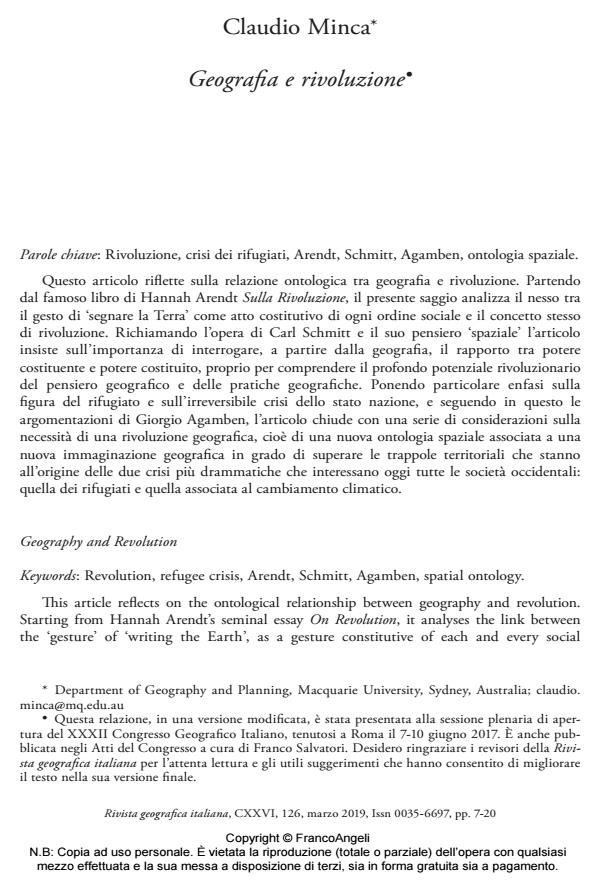Geography and Revolution
Journal title RIVISTA GEOGRAFICA ITALIANA
Author/s Claudio Minca
Publishing Year 2019 Issue 2019/1
Language Italian Pages 14 P. 7-20 File size 175 KB
DOI 10.3280/RGI2019-001001
DOI is like a bar code for intellectual property: to have more infomation
click here
Below, you can see the article first page
If you want to buy this article in PDF format, you can do it, following the instructions to buy download credits

FrancoAngeli is member of Publishers International Linking Association, Inc (PILA), a not-for-profit association which run the CrossRef service enabling links to and from online scholarly content.
This article reflects on the ontological relationship between geography and revolution. Starting from Hannah Arendt’s seminal essay On Revolution, it analyses the link between the ‘gesture’ of ‘writing the Earth’, as a gesture constitutive of each and every social Department of Geography and Planning, Macquarie University, Sydney, Australia; claudio. minca@mq.edu.au - Questa relazione, in una versione modificata, è stata presentata alla sessione plenaria di aper¬tura del XXXII Congresso Geografico Italiano, tenutosi a Roma il 7-10 giugno 2017. È anche pub¬blicata negli Atti del Congresso a cura di Franco Salvatori. Desidero ringraziare i revisori della Rivi¬sta geografica italiana per l’attenta lettura e gli utili suggerimenti che hanno consentito di migliorare il testo nella sua versione finale. order, and the original conceptualizations of the term revolution. By engaging with Carl Schmitt’s oeuvre, and his spatial thought in particular, this essay speculates at length on the importance of interrogating - from a geographical perspective - the foundational relationship between pouvoir constitutif and pouvoir constitué in order to appreciate the profound revolutionary potential inherent to geographical thought and geographical practice. Placing particular emphasis of the figure of the refugee and on the related irreversible crisis of the nation state - following in this Giorgio Agamben’s work on the same topic - the article concludes with a series of consideration on the need for a geographical revolution, that is, a new spatial ontology associated to new geographical imaginations capable of moving beyond the territorial traps at the origin of the two most urgent crises affecting today all western societies: the refugee crisis and that associate to global climate change.
Keywords: Revolution, refugee crisis, Arendt, Schmitt, Agamben, spatial ontology
- Geopolitical Perspectives from the Italian Border Christian Sellar, Gianfranco Battisti, pp.3 (ISBN:978-3-031-26043-8)
- Conciliating Subaltern and Liminal Geopolitics: Reggio Emilia’s City Diplomacy and the Geographies of Lusophone Africa’s Decolonisation Federico Ferretti, in Geopolitics /2024 pp.1
DOI: 10.1080/14650045.2023.2291067 - Geography, pluriverse and ‘Southern Thought’: Engaging with decoloniality from the Mediterranean Federico Ferretti, in Political Geography 102990/2023 pp.102990
DOI: 10.1016/j.polgeo.2023.102990 - Geografia sociale dell’integrazione. Le voci dei migranti forzati nella Città metropolitana di Milano Giuseppe Gambazza, in Geography Notebooks 9/2021
DOI: 10.7358/gn-2021-002-gag1 - Geographies of revolution: Prefiguration and spaces of alterity in Latin American radicalism Federico Ferretti, in Environment and Planning C: Politics and Space /2022 pp.1147
DOI: 10.1177/23996544211063163 - Pathways Through the Sea: Decolonial Geopoetics of the Mediterranean in Italian Folksong Federico Ferretti, in GeoHumanities /2024 pp.300
DOI: 10.1080/2373566X.2024.2396469 - Spazi del cosmopolitismo: una riflessione critico-geografica Nicolò Matteucci, in RIVISTA GEOGRAFICA ITALIANA 2/2025 pp.116
DOI: 10.3280/rgioa2-2025oa20571
Claudio Minca, Geografia e rivoluzione in "RIVISTA GEOGRAFICA ITALIANA" 1/2019, pp 7-20, DOI: 10.3280/RGI2019-001001